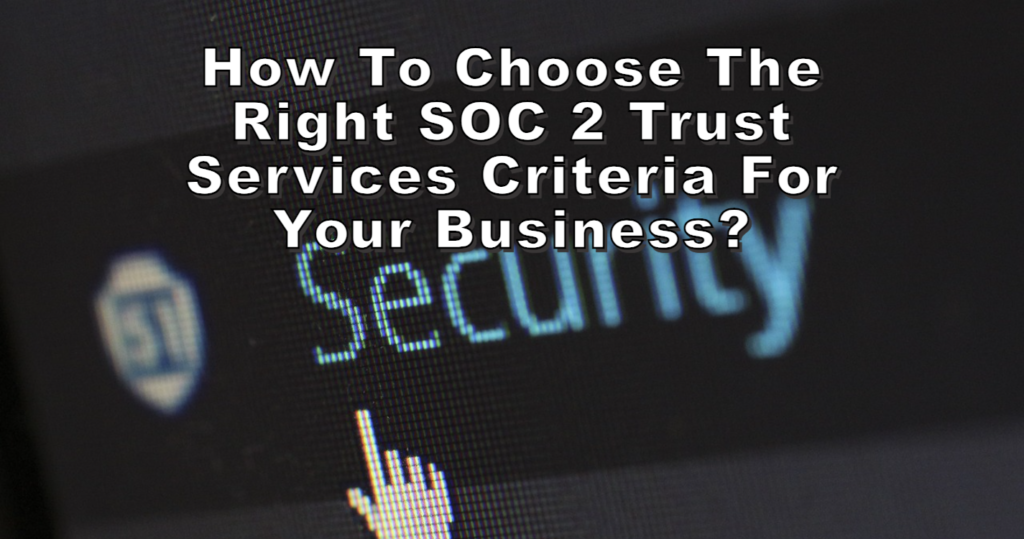Selecting the appropriate SOC 2 Trust Services Criteria (TSC) is a critical step for any organization seeking to demonstrate its commitment to data security and compliance. The SOC 2 framework, developed by the American Institute of Certified Public Accountants (AICPA), provides five criteria—Security, Availability, Processing Integrity, Confidentiality, and Privacy—that organizations can include in their audits. Choosing the right combination of these criteria ensures alignment with your business objectives, customer expectations, and regulatory requirements.

Start with Security: The Foundation of SOC 2
The Security criterion is mandatory for all SOC 2 audits and serves as the foundation of the framework. It evaluates whether your organization has controls in place to protect systems and data from unauthorized access, breaches, or damage. Regardless of your industry, this criterion is non-negotiable and must be included in every SOC 2 report. It ensures basic cybersecurity hygiene and builds trust with clients by demonstrating your commitment to safeguarding their information.
Define Your Business Scope and Objectives
Before selecting additional criteria, assess your organization’s operations, services, and the type of data you handle. This involves identifying touchpoints where customer data is processed, stored, or transmitted. For instance, a cloud service provider may prioritize system availability to ensure uninterrupted service delivery, while a healthcare organization might focus on confidentiality and privacy due to sensitive patient information.
Understanding your business scope helps determine which criteria are most relevant. For example:
– If system uptime is critical to your operations, such as for SaaS platforms or e-commerce sites, consider adding Availability.
– If you process financial transactions or require operational accuracy, Processing Integrity may be essential.
– If you handle sensitive or proprietary information like trade secrets or intellectual property, Confidentiality should be prioritized.
– If personal data protection laws like GDPR or CCPA apply to you, include Privacy.
Align with Customer Expectations
Your clients’ needs often dictate which criteria should be included in your SOC 2 audit. Many customers expect assurances that align with their own compliance obligations or operational priorities. For example:
– Clients in regulated industries may require evidence of robust privacy controls.
– Enterprise customers might demand high availability to avoid disruptions in their supply chain.
Engaging with stakeholders early in the process can help clarify these expectations and ensure that your chosen criteria address their concerns.
Consider Industry Standards and Regulatory Requirements
Different industries emphasize specific aspects of the Trust Services Criteria based on their unique risks and compliance landscapes:
– Healthcare: Focus on Confidentiality and Privacy due to HIPAA requirements.
– Finance: Emphasize Processing Integrity to ensure accurate transaction processing.
– Technology: Prioritize Security and Availability for robust system performance and data protection.
Reviewing applicable laws, regulations, and industry standards will help you align your SOC 2 audit with external expectations.
Evaluate Internal Resources and Readiness
Implementing controls for each criterion requires time, effort, and resources. Organizations with limited capacity may choose to start with Security alone and expand their scope over time as they mature. For example:
– Begin by meeting Security requirements to establish a baseline.
– Gradually add other criteria based on client demand or operational goals.
This phased approach allows organizations to achieve compliance incrementally while maintaining focus on their core business activities.
Build a Roadmap for Compliance
Once you’ve identified the relevant criteria, create a roadmap for implementation. This includes:
1. Establishing policies and procedures that align with the selected criteria.
2. Conducting risk assessments to identify vulnerabilities.
3. Implementing technical controls such as encryption or access management tools.
4. Training employees on compliance practices.
Regular internal audits can help ensure ongoing adherence to the chosen criteria while preparing for external SOC 2 assessments.
Conclusion
Choosing the right SOC 2 Trust Services Criteria is not a one-size-fits-all decision; it requires careful consideration of your business model, client needs, industry standards, and resource availability. By starting with Security as a foundation and tailoring additional criteria based on your unique objectives, you can build a robust compliance framework that protects customer data while fostering trust and transparency.